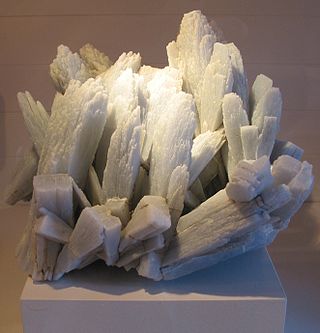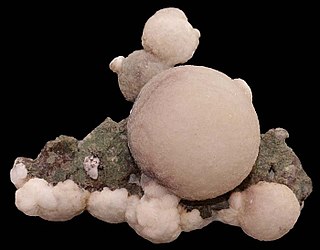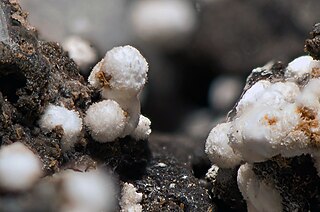
Analcime (; from Ancient Greek ἀνάλκιμος (análkimos) 'not strong') or analcite is a white, gray, or colorless tectosilicate mineral. Analcime consists of hydrated sodium aluminium silicate in cubic crystalline form. Its chemical formula is NaAlSi2O6 · H2O. Minor amounts of potassium and calcium substitute for sodium. A silver-bearing synthetic variety also exists (Ag-analcite). Analcime is usually classified as a zeolite mineral, but structurally and chemically it is more similar to the feldspathoids. Analcime is not classified as an isometric crystal, as although the crystal structure appears to be isometric, it is usually off only by a fraction of an angle. However, there are truly isometric samples of the mineral, which makes its classification even more difficult. Due to the differences between the samples being too slight, there's no merit from having multiple species names, so as a result analcime is a common example for minerals occurring in multiple crystal systems and space groups. It was first described by French geologist Déodat de Dolomieu, who called it zéolithe dure, meaning hard zeolite. It was found in lava in Cyclops, Italy. The mineral is IMA approved, and had been grandfathered, meaning the name analcime is believed to refer to a valid species til this day.

Celestine (the IMA-accepted name) or celestite is a mineral consisting of strontium sulfate (SrSO4). The mineral is named for its occasional delicate blue color. Celestine and the carbonate mineral strontianite are the principal sources of the element strontium, commonly used in fireworks and in various metal alloys.

Stilbite is the name of a series of tectosilicate minerals of the zeolite group. Prior to 1997, stilbite was recognized as a mineral species, but a reclassification in 1997 by the International Mineralogical Association changed it to a series name, with the mineral species being named:

Anhydrite, or anhydrous calcium sulfate, is a mineral with the chemical formula CaSO4. It is in the orthorhombic crystal system, with three directions of perfect cleavage parallel to the three planes of symmetry. It is not isomorphous with the orthorhombic barium (baryte) and strontium (celestine) sulfates, as might be expected from the chemical formulas. Distinctly developed crystals are somewhat rare, the mineral usually presenting the form of cleavage masses. The Mohs hardness is 3.5, and the specific gravity is 2.9. The color is white, sometimes greyish, bluish, or purple. On the best developed of the three cleavages, the lustre is pearly; on other surfaces it is glassy. When exposed to water, anhydrite readily transforms to the more commonly occurring gypsum, (CaSO4·2H2O) by the absorption of water. This transformation is reversible, with gypsum or calcium sulfate hemihydrate forming anhydrite by heating to around 200 °C (400 °F) under normal atmospheric conditions. Anhydrite is commonly associated with calcite, halite, and sulfides such as galena, chalcopyrite, molybdenite, and pyrite in vein deposits.

Tremolite is a member of the amphibole group of silicate minerals with composition Ca2(Mg5.0-4.5Fe2+0.0-0.5)Si8O22(OH)2. Tremolite forms by metamorphism of sediments rich in dolomite and quartz, and occurs in two distinct forms, crystals and fibers. Tremolite forms a series with actinolite and ferro-actinolite. Pure magnesium tremolite is creamy white, but the color grades to dark green with increasing iron content. It has a hardness on Mohs scale of 5 to 6. Nephrite, one of the two minerals known as the gemstone jade, is a green crystalline variety of tremolite.

Natrolite is a tectosilicate mineral species belonging to the zeolite group. It is a hydrated sodium and aluminium silicate with the formula Na2Al2Si3O10·2H2O. The type locality is Hohentwiel, Hegau, Germany.

Scolecite is a tectosilicate mineral belonging to the zeolite group; it is a hydrated calcium silicate, CaAl2Si3O10·3H2O. Only minor amounts of sodium and traces of potassium substitute for calcium. There is an absence of barium, strontium, iron and magnesium. Scolecite is isostructural (having the same structure) with the sodium-calcium zeolite mesolite and the sodium zeolite natrolite, but it does not form a continuous chemical series with either of them. It was described in 1813, and named from the Greek word, σκώληξ (sko-lecks) = "worm" because of its reaction to the blowpipe flame.

The chlorites are the group of phyllosilicate minerals common in low-grade metamorphic rocks and in altered igneous rocks. Greenschist, formed by metamorphism of basalt or other low-silica volcanic rock, typically contains significant amounts of chlorite.

Heulandite is the name of a series of tecto-silicate minerals of the zeolite group. Prior to 1997, heulandite was recognized as a mineral species, but a reclassification in 1997 by the International Mineralogical Association changed it to a series name, with the mineral species being named:

Gmelinite-Na is one of the rarer zeolites but the most common member of the gmelinite series, gmelinite-Ca, gmelinite-K and gmelinite-Na. It is closely related to the very similar mineral chabazite. Gmelinite was named as a single species in 1825 after Christian Gottlob Gmelin (1792–1860) professor of chemistry and mineralogist from Tübingen, Germany, and in 1997 it was raised to the status of a series.
Gmelinite-Na has been synthesised from Na-bearing aluminosilicate gels. The naturally occurring mineral forms striking crystals, shallow, six sided double pyramids, which can be colorless, white, pale yellow, greenish, orange, pink, and red. They have been compared to an angular flying saucer.

Cavansite, named for its chemical composition of calcium vanadium silicate, is a deep blue hydrous calcium vanadium phyllosilicate mineral, occurring as a secondary mineral in basaltic and andesitic rocks along with a variety of zeolite minerals. Its blue coloring comes from vanadium, a metal ion. Discovered in 1967 in Malheur County, Oregon, cavansite is a relatively rare mineral. It is polymorphic with the even rarer mineral, pentagonite. It is most frequently found in Pune, India, and in the Deccan Traps, a large igneous province.

Thomsonite is the name of a series of tecto-silicate minerals of the zeolite group. Prior to 1997, thomsonite was recognized as a mineral species, but a reclassification in 1997 by the International Mineralogical Association changed it to a series name, with the mineral species being named thomsonite-Ca and thomsonite-Sr. Thomsonite-Ca, by far the more common of the two, is a hydrous sodium, calcium and aluminium silicate, NaCa2Al5Si5O20·6H2O. Strontium can substitute for the calcium and the appropriate species name depends on the dominant element. The species are visually indistinguishable and the series name thomsonite is used whenever testing has not been performed. Globally, thomsonite is one of the rarer zeolites.
Zeolite facies describes the mineral assemblage resulting from the pressure and temperature conditions of low-grade metamorphism.

Brewsterite is the name of a series of tectosilicate minerals of the zeolite group. Prior to 1997, brewsterite was recognized as a mineral species, but a reclassification in 1997 by the International Mineralogical Association changed it to a series name, with the mineral species being named brewsterite-Sr and brewsterite-Ba. Brewsterite-Sr, the more common of these, is a hydrous strontium and aluminium silicate, (Sr,Ba)2Al4Si12O32·10H2O. Small amounts of barium is usually present replacing part of the strontium. The appropriate species name depends on the dominant element. The species are visually indistinguishable, and the series name brewsterite is still used whenever testing has not been performed.

Fluorapatite, often with the alternate spelling of fluoroapatite, is a phosphate mineral with the formula Ca5(PO4)3F (calcium fluorophosphate). Fluorapatite is a hard crystalline solid. Although samples can have various color (green, brown, blue, yellow, violet, or colorless), the pure mineral is colorless, as expected for a material lacking transition metals. Along with hydroxylapatite, it can be a component of tooth enamel, especially in individuals who use fluoridated toothpaste, but for industrial use both minerals are mined in the form of phosphate rock, whose usual mineral composition is primarily fluorapatite but often with significant amounts of the other.

Partheite or parthéite is a calcium aluminium silicate and a member of the zeolite group of minerals, a group of silicates with large open channels throughout the crystal structure, which allow passage of liquids and gasses through the mineral. It was first discovered in 1979 in rodingitic dikes in an ophiolite zone of the Taurus Mountains in southwest Turkey. The second discovery occurred in gabbro-pegmatites in the Ural Mountains, Russia. Since its discovery and naming, the chemical formula for partheite has been revised from CaAl2Si2O8·2H2O to include not only water but hydroxyl groups as well. The framework of the mineral is interrupted due to these hydroxyl groups attaching themselves to aluminum centered oxygen tetrahedra. This type of interrupted framework is known in only one other zeolite, the mineral roggianite. As a silicate based mineral with the properties of a zeolite, partheite was first described as zeolite-like in 1984 and listed as a zeolite in 1985. Partheite and lawsonite are polymorphs. Associated minerals include prehnite, thomsonite, augite, chlorite and tremolite.

Stellerite is a rare mineral discovered by and named after Georg Wilhelm Steller, a German explorer and zoologist. The mineral has a general formula of Ca[Al2Si7O18]·7H2O. Like most rare minerals, there are few commercial uses for stellerite. Mineral collectors are lucky to find it in good enough crystal form. Zeolites, including stellerite, have been studied using a dehydration process to gauge the potential use of their phases as molecular sieves, sorbents, and catalysts. Its occurrences are in cavities of andesite as sheaf-like clusters of small crystals.

Garronite-Ca is a fairly rare silicate mineral, from the zeolite, which has been found in a few dozen locations in the world. It was first found in the Glenariff Valley, Garron Plateau, County Antrim, Northern Ireland, and in some locations in Iceland. The name comes from the town of Garron, in Northern Ireland, which is consequently considered its type locality. The name initially used was that of Garronite, without subfixes, but the discovery in 2015 of a garronite with dominant sodium instead of calcium in the position of interchangeable cations made it necessary to use subfixes, remaining as Garronite-Ca, to distinguish it from the new species, Garronite-Na.

Bavenite is a calcium beryllium aluminosilicate, and it is a part of the Bavenite-Bohseite series. Its name originates from its type locality, which is Baveno, Italy. This mineral is approved by the IMA, and got grandfathered, meaning it is still believed to refer to a valid mineral species. It was discovered in 1901 in a pink granite mined in Lago Maggiore. When bavenite was discovered, it was considered as a member of the zeolite series. Later it was removed from the series as unlike zeolites, bavenite loses the water stored in its crystal lattice in a way higher temperature, between 210 and 320 °C. It is a cheap mineral considering its rarity.

Tacharanite is a calcium aluminium silicate hydrate (C-A-S-H) mineral of general chemical formula Ca12Al2Si18O33(OH)36 with some resemblance to the calcium silicate hydrate (C-S-H) mineral tobermorite. It is often found in mineral assemblage with zeolites and other hydrated calcium silicates.




















